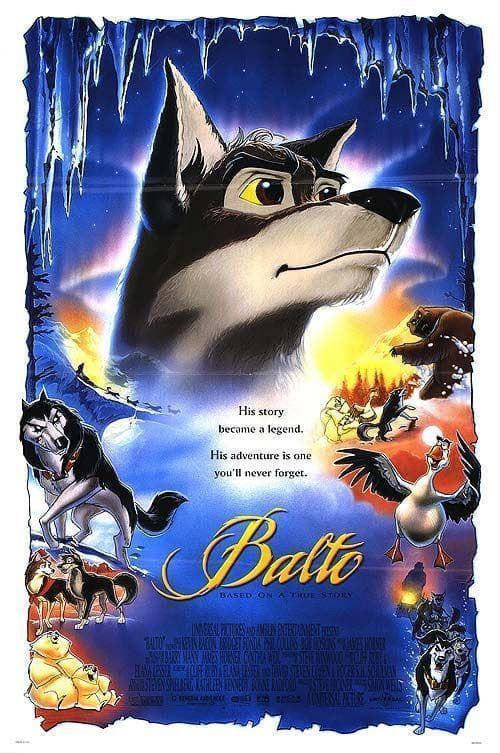
And if reference is made to Balto, he was a Siberian Husky dog considered a hero in the United States, to the point of having a statue in his honor in the heart of Central Park, in New York, and his own animated film (1994), it is mandatory to do the same with Togo (2019).
This film tells the true story of the sled dog that won the most important race in this discipline held in 1925.
All this despite not being "fit" to finish it, as they considered it to be because of its small proportions.
With this, the animal achieved the feat of helping to end the fearsome outbreak of diphtheria, a deadly disease that hit an Alaskan town in the form of an epidemic.

The Disney work, which has a cast led by Willem Dafoe, brings us closer to the event that took place and how Togo faced a real threat that, almost a hundred years later, the world has proven how real it can be.
In addition, the story returns that lost prominence to both Togo and his human partner Sepp.
And it is that the name of Balto would end up being the most valued, even though Togo would be the one that would travel the most kilometers transporting the serum through more dangerous terrain.
The need for a hero made Balto take the credit (deserved, no doubt) and the name of Togo was forgotten, to this day.
At the beginning of 1925, a relay of sleds of more than 1,000 kilometers and under temperatures of -40ºC, managed to take from Anchorage, the capital of Alaska, to Nome, a shipment of vaccines against diphtheria.
The outbreak of this disease managed to subside thanks, among others, to dogs like Balto, who was the "guide dog" during the last two sections.
For his heroism, a statue was erected in his honor in Central Park (New York).
There are dogs, like Balto, that have gone down in history for their dedication.
This husky was one of the dogs that at the beginning of 1925 took part in the sled relay that managed to bring the vaccines to Nome (Alaska) that put an end to the diphtheria outbreak that had begun to spread among the child population of this city.
So much was Balto's role in that heroic deed, that two statues in his honor stand today in Anchorage, the capital of Alaska, and in Central Park (New York) and even Hollywood made a cartoon movie that narrates the feat he represented. travel more than 1,000 kilometers by sled having to overcome the icy cold of Alaska.
When the diphtheria epidemic began in Nome in January 1925, the closest vaccines were in Anchorage, some 900 kilometers away, at the time that a major storm prevented the shipment from reaching it by sea or air, so it was He opted for a risky and very tough sled relay in which twenty volunteer “mushers” (sledge drivers) participated with their respective Siberian husky dog teams.
The epic, which began on January 27 at the Nenana train station, reached the penultimate relay with the Norwegian "musher" Gunnar Kaasen in whose dog pack was Balto, a six-year-old black husky with apparent little physical potential, a circumstance which caused Kaasen to initially drop him to the rear, although the unexpected injury to the team's "guide dog" put Balto in front of the sled dogs.
But the problems had only just begun.
Kaasen arrived at the relay on February 2, ahead of schedule and without the replacement sled being ready to leave, forcing him and his dogs to also make the final leg of the journey in -40C temperatures. .
Finally, the diphtheria vaccines arrived in Nome on time.
After this feat, which was widely publicized by the media of the time, Balto ended his days at the Cleveland Zoo where he died at the age of fourteen and his dissected body is currently on display at the Cleveland Museum of Natural History. same city.
It sounds like a story from Jack London's novels.
In the dead of winter, a deadly disease afflicts the children of an Alaskan gold rush town, isolated between a frozen sea and a wilderness buried under snow.
Residents' only hope is a sketchy plan to bring treatment vials from a power line hundreds of miles across mountains, across frozen coves and through a storm.
On a dog sled.
But this story is not fiction. The 1925 serum race (as those who know it call it) was an event of such importance that a statue was dedicated to it in New York's Central Park, a space that it shares with 29 other artistic commemorations, such as representations of Christopher Columbus, characters from Shakespeare and Alice in Wonderland and the John Lennon Memorial Mosaic.
It is a statue of a dog with a stocky build and a heroic pose that children love to climb on.
For those who see her as more than a goal, she is a testament to loyalty, tenacity, and a duty to work for the greater good. The dog's name, carved into the base of the statue, is Balto. I should probably say something else.
The story of somewhat usurped heroism (one that is the very definition of triumph against the odds) is the basis of Togo, a new Disney+ original film that tells a familiar tale, but with some unknown names.
One is that of the eponymous hound that perhaps deserved to be the one carved in bronze and that children climb on; the other is that of its owner, a Norwegian immigrant and failed gold digger turned dog breeder named Leonhard Seppala.
None of the names is as well known as it should be, much less for Willem Dafoe, the actor who would end up playing Seppala in what would be a first step into the world of a man he had not yet met.
"I knew the basic story about the serum run," he told National Geographic UK. «The story of Leonhard Seppala and Togo, not so much. Normally, when people know the story, they know Balto."
Nome, high on the west coast of Alaska on the Bering Sea, is a frontier town built on the gold and fur trade.
It was founded in 1901 and is closer to Siberia than to the state's largest city, Anchorage.
Its remote location would present a nightmarish situation when, in 1925, an illness began to affect the town's children.
By the time the authorities discovered that it was not a serious outbreak of tonsillitis, it was too late: it was diphtheria.
Diphtheria, a contagious bacterial infection that attacks the upper respiratory tract and causes inflammation of the tissues in the throat, can be deadly.
So it was in Nome: in late December, two Iñupiaq children had succumbed to the disease when it was discovered that the only supplies of antitoxin from the small local hospital had expired.
By January 24, four children had died, and more were presumed dead in surrounding Alaskan Native communities.
In a telegram to Anchorage, Nome doctor Curtis Welch said he had placed a quarantine and requested that a million units be sent to them, assuring that the "epidemic of diphtheria is almost inevitable."
The fact that this outbreak was unprecedented was even more terrifying.
“In Alaskan history, the 1925 diphtheria outbreak in Nome was one of a series of epidemics in the area and throughout Alaska,” says David Reamer, a historian and writer for The Anchorage Daily News who has written extensively on Alaska. diseases in the history of the state.
“Nome and the surrounding native villages were by far the Alaskan communities most affected by the influenza pandemic of 1918-1919, the Spanish flu.
Hundreds of people died in the region.
There were babies who froze to death in their mothers' arms, who had succumbed to the flu," he says.
"This horror, just seven years earlier, was a vivid memory and was certainly on the minds of residents as they watched diphtheria spread among their children."
With some of the worst winter conditions in decades and the lowest temperatures in 20 years, Nome officials quickly understood that transporting a small supply of antitoxin across Alaska by conventional means would be too slow or impossible before the disease swept through the country. location.
The port was frozen and flying was unsafe due to the cold, let alone landing.
With no other way to bridge the massive 1,085-kilometer gap between the head of the line at Nenana and Nome (a route that used to take a month for couriers to traverse), they turned to a champion dog breeder and musher named Leonhard Seppala (a musher is the driver of the dog sled).
Seppala's own history spanned many miles.
"Sepp", a Norwegian immigrant, had traveled to Alaska in search of gold and worked for a mine.
Disillusioned with his job, he became a superintendent.
His job was to take care of the ditches and transport cargo and passengers between camps by dog sled and in a pupmobile (dogmobile) designed to circulate on the railways.
"He's a character from a certain time in history," says Dafoe, whose appearance in Togo as a mysterious-looking Seppala has received acclaim from audiences and critics.
“He reminds me of men I have known throughout my life, like my father. People said he was a very pragmatic guy. Not taciturn, just pragmatic.
It is that adventurous spirit of getting ahead on your own, of being independent, of learning things. To take care of yourself and not accept charity from anyone.
Driven by his work and tasked by default with the training and maintenance of the mine's dogs, Seppala found his calling.
Having connections to the enterprising owner of the mine, Seppala was commissioned by Norwegian explorer Roald Amundsen to train and condition a team of puppies as sled dogs to attempt to reach the North Pole from Alaska.
Faced with the prospect of World War I, they canceled the expedition and gave away the dogs that were going to participate to Seppala.
Sled racing was a natural and collateral activity for anyone who worked with dogs, whether they were the Alaskan malamute, the husky (derived from esky, short for "Eskimo"), and the Siberian dogs brought to Alaska by the Chukchis in 1908 .
The propulsive gait of these dogs, their endurance and intelligence made them the perfect engine to traverse difficult terrain.
Amundsen's trained dogs were Siberian huskies, so Sepp (who now had his own team) began racing in Alaska. Beginning in 1915, Seppala won three consecutive victories in the All Alaska Sweepstakes, a 400-mile (656-kilometer) no-holds-barred race from Nome to Candle that followed the route of the telegraph line.
Seppala's victories were credited to his lightly built dogs, which other mushers called "Siberian rats."
That and the instincts of the lead dog, a position Seppala would soon assign to a particular dog.

THE STORY OF TOGO:
Togo, named after the heroic Japanese admiral Heihachiro Togo, was born in 1913.
At first, his future in dog racing did not look very promising.
He had a mottled color that gave his coat a grimy appearance, and was bred by Seppala's wife, Constance, as a cub due to a throat ailment, a circumstance that may account for his smaller build, willing temperament, and ingrained loyalty. to his owner.
Togo would often sneak out to run after Seppala when training or running errands.
As he considered it a nuisance, at seven months he gave it to a friend as a pet, but Togo ran away and returned home.
At this point, Seppala noticed an indirect virtue of the dog: its determination and its ability to find the shortest distance between two points.
Dafoe, whose portrayal of the mysterious Seppala in Togo has received wide acclaim, believes the Norwegian saw something of himself in the dog. “Seppala was quite determined.
He was of small constitution, he was an immigrant and he had had some disappointments in his life, “he says.
"So, in a way, that was analogous to their projections in Togo, which was kind of doomed.
He was too small, he was unassuming, he was undisciplined, and he was basically branded a failure. Maybe he identified with that."
Although he may have been a poor prospector, Seppala eventually found his own niche. "I think it's always helpful to play a character that has a very central action, or experience, or passion, or profession," says Dafoe. "I always feel like the way to get into the characters is to know how they do what they do or to adapt to their way of thinking in the most practical way possible."
For Togo, that meant taking charge and physically learning Seppala's chosen profession. "You think it looks easy, it's a guy sitting in the back and the dogs are the only ones pulling," he jokes. "But it's not that simple. You have to get to know the dogs, fine-tune the tension of the rope, deal with discomfort, the cold, keep your balance, read the terrain; are a lot of things. It takes a very tough character."
Fed up with Togo's constant running away, Seppala allowed him to run with the team, first behind, then further in front and finally in the lead, where the dog really shone. In Gay and Laney Salisbury's The Cruelest Miles, Seppala is quoted as saying that in Togo he "found a born leader...something he had been trying to breed for years." Both would become inseparable and, in the years to come, on their many expeditions, they would save each other's lives.
THE GREAT RACE OF MERCY:
By the time the diphtheria outbreak hit, Seppala was already a famous musher throughout Alaska (they called him "King of the Trail"), and his wily little Togo was equally revered as a guide dog.
On the night of January 14, 1925, Seppala was called upon by Nome authorities to lead what would become known, in the hyperbole of many subsequent headlines, the "Great Mercy Race."
Since the nearly 1,300-mile round trip from Nome to Nenana was impossible for a single team, the vials of diphtheria antitoxin (the only 300,000 units in Alaska) would be transported by teams of sled dogs from Nenana to Nome. through a medium scale in Nulato. In this way, each journey would be just over 1000 kilometers.
The dangers were considerable.
Seppala would handle the most treacherous sections of the intercept leg from Nome and be forced to negotiate the shoreline of Norton Sound, a strait that bore the chilling nickname of 'the ice factory'.
The most dangerous part of the journey would be cutting through the frozen strait, a shortcut that would save him a day, but was plagued by high winds and sharp, unstable ice floes.
It was a stage that many (Seppala included) knew only he could manage with Togo's instincts to read danger and terrain. But even this would be a difficult task: at that time, Togo was already 12 years old.
Seppala departed on January 27.
As the outbreak and weather conditions worsened, Seppala would move forward unaware that already unlikely plans had been changed en route.
Thus, they ran a considerable risk of missing a meeting in the rustic cabins or "paradores", the only respite along the route. As the Nome outbreak worsened, more mushers and equipment were added to relieve pressure and speed the transit of medication, ampoules wrapped in hair and sealed in a metal container.
The relay from Nenana progressed faster than expected. By sheer luck, Seppala intercepted the serum of a musher named Henry Ivanoff outside of Shahtoolik and returned to Nome in worse condition.
In the region, temperatures were -35 degrees with wind chills of -65.
Seppala relied on Togo's instincts when he couldn't see the road due to foam, headwind and deep snow.
Due to his exhaustion and that of his dogs, Seppala was forced to stop at Golovin with 125 kilometers to go to Nome.
Since the start, the team had covered a total of 420 kilometers and crossed Norton Sound twice on treacherous ice.
Later, a musher named Charlie Olsen transported the antitoxin some 50 kilometers from Nome, where Gunner Kaasen was waiting with a team of 13 dogs led by Balto.
Balto's resulting fame, along with that of the musher Kaasen, was an unfortunate but unintended consequence.
The antitoxin's 1,085-kilometre journey took five and a half days, a world record witnessed by an audience on tenterhooks.
It was accentuated by the recent adoption of radio by the American middle class, which turned the story of the serum race into a remotely broadcast phenomenon.
In Nome, between five and seven people died, although the death toll among native Alaskans outside the town was not recorded and was likely much higher.
Still, it became clear that further loss of life had been miraculously avoided. The story became a sensation, and so did its heroes.
Balto was the dog that led the final stage to Nome and allowed Kaasen to deliver the antitoxin on February 2nd.
A simple look at the mileage would have put that miscredit into context: Balto and Fox, with Kaasen, covered 80, 85, or 88 kilometers (sources vary), while Seppala, with Togo, hauled the serum 146 kilometers over a stretch of terrain. much more technical and dangerous. In total, Togo traveled 420 kilometers from door to door; Balto, just over 160.
But the public wanted a hero and they chose Kaasen and Balto, the faces of Nome's salvation.
Their photos appeared on the front pages of newspapers and their names would go down in history, eclipsing not only Togo and Seppala, but the other 18 people and some 150 dogs who participated in the relay. "By and large, Balto's fame obscures other mushers, including many native Alaskans whose contributions have been much more forgotten."
A DESERVED RECOGNITION:
Kaasen and Balto's stage was also heroic: although they didn't do as many kilometres, the conditions were so bad that Kaasen, who rode at night, barely saw the dogs.
Along the way, the sled overturned and he had to search for the antitoxin packet in the snow with his bare hands, resulting in frostbite injuries.
All in all, the competitive Seppala wasn't too happy with the adulation Balto received.
Although he was the owner, breeder and trainer of the dog that Kaasen had used on his team, Seppala maintained that Balto was a "second dog" compared to his beloved Togo and that Balto had been co-leader with a dog named Fox for those last few miles. .
The New York Times added to the confusion in 1927, when it reported that Balto was not the real hero of the serum run, but Fox. The rest of the brief, which did not mention Togo, was devoted to Balto's supposed whereabouts.
The latter had suffered a cruel twist of fate. T
After the serum run, in addition to the statue in Central Park, Balto was awarded the key (in the form of a bone) to the city of Los Angeles, acted in a movie, and toured the contiguous United States before an admiring audience.
But when Kaasen had had enough and wanted to return to Alaska, Balto and his fellow canines were sold (by whom) to a vaudeville sideshow.
There he suffered mistreatment until a fundraiser got him admitted to the Cleveland Zoo, where he lived to the end of his days.
TRUTH VS. LEGEND:
As Balto's name has already enjoyed fame, books, statues, and even a cartoon movie (dubbed in the original version by Kevin Bacon and in Spanish by Juan Antonio Bernal), Alaskan historian David Reamer is pleased to see that the new film will clarify the matter. "The film manages to right a historical injustice without getting bogged down in minutiae," he says. "The story doesn't need more drama, that's for sure."
The whey run also inspired the world's most famous sled dog race, the Iditarod, which follows a similar route between Nome and Nenana before heading south to Anchorage. Togo's lineage continues in the Siberian Seppala and the 107-year-old dog "lives" at the Iditarod headquarters in Wasilla, displayed in a glass case (Seppala mounted his hair after his death).
The dog and the race date back to a time in Alaskan history when the sled dog was vital to human survival in the wilderness.
"Alaskan literature is full of stories about dogs who are born leaders like Togo...with an almost uncanny ability to assess obstacles," Gay and Laney Salisbury wrote in The Cruellest Miles. "Without those dogs, many Alaskans believe that Alaska could not have developed."
Also, the race itself had another legacy: it saved thousands or even hundreds of thousands of lives for the next generation. "At a time when supplying much-needed antitoxin was not feasible by air or sea (along with the determination and tenacity to save the children of Nome), the story of the dog sled relay fueled the need and importance of vaccination,” says Dr Basil Aboul Enein of the London School of Hygiene and Tropical Medicine. "It's a story that still echoes in the annals of public health history."
The problem of the Balto statue in Central Park also continues to echo.
In late 2019, a Change.org petition was created to replace Balto's statue with Togo's.
In New York's Seward Park there's a small statue of Togo unveiled in 2001 and recently moved to a more prominent spot during the park's renovation (Seward is the last name of the Secretary of State who bought Alaska from Russia in 1868).
Regarding the film, Willem Dafoe is sure that the story of Seppala and Togo goes beyond correcting a dog's usurpation of fame. "It's going to have different meanings to different people, like everything. I guess the main thing is to open up to where you fit in the world," he says. "The interdependence between us and nature, us and the animals... so that it leads to a better way of life and a better understanding of why we are here."
"Everyone wants to be useful. I think this was his moment, he felt like it was something he had to try. I don't think I had any choice."

Other articles that might interest you:
- Laika, the first space dog.
- Chonino, the dog that was sacrificed.
- Stubby and Smoky, fighting dogs.
- Barry, a hero in the snow.
- Old Drum and animal rights.
- RIN TIN TIN, Hollywood star.
- HACHIKO, loyal to the end.
Glu Glu Pet products that we recommend:
- HEALTHY PET SALMON OIL 500ml.
- Advance appetite control snacks.
- ANC Fresh pork snacks.
- ANC fresh salmon snacks.
- ANC snacks fresh chicken.
- Chicken rings 6cm.
- GOAT HORN.









